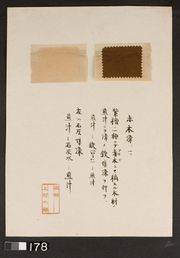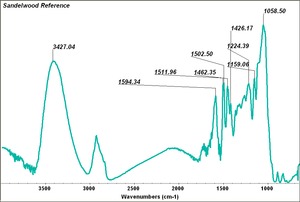Difference between revisions of "Sandalwood dye"
| (6 intermediate revisions by the same user not shown) | |||
| Line 1: | Line 1: | ||
| + | [[File:Uemura 07-09-2009 178.jpg|thumb|Two samples Sandalwood dye on silk<br> Uemera Dye Archive]] | ||
== Description == | == Description == | ||
| − | + | A water insoluble red dye from sandalwood, ''Pterocarpus santalinus'', that grows in tropical Asia. Sandalwood dye contains santalin as the primary colorant. It is soluble in alcohol but not in water. The fugitive color has been used for textiles and for tanning [[leather|leather]]. Similar water insoluble dyes are obtained from [[barwood|barwood]], camwood, and narrawood. | |
| + | See also [[https://cameo.mfa.org/wiki/Category:Uemura_dye_archive '''Uemera Dye Archive''' (Akagi)]] | ||
== Synonyms and Related Terms == | == Synonyms and Related Terms == | ||
| Line 9: | Line 11: | ||
[[[SliderGallery rightalign|Sandelwood.TIF~FTIR (MFA)]]] | [[[SliderGallery rightalign|Sandelwood.TIF~FTIR (MFA)]]] | ||
| − | == | + | == Physical and Chemical Properties == |
| − | + | * Soluble in methanol, ethanol, ether, sulfuric acid. | |
| + | * Insoluble in water. | ||
| − | == | + | ==Resources and Citations== |
| − | J.Hofenk-de Graaf, ''Natural Dyestuffs: Origin, Chemical Constitution, Identification'', Central Research Laboratory for Objects of Art and Science, Amsterdam, September 1969. | + | * J.Hofenk-de Graaf, ''Natural Dyestuffs: Origin, Chemical Constitution, Identification'', Central Research Laboratory for Objects of Art and Science, Amsterdam, September 1969. |
| − | |||
| − | |||
* R.J. Adrosko, ''Natural Dyes in the United States'', Smithsonian Institution Press, Washington, DC, 1968 | * R.J. Adrosko, ''Natural Dyes in the United States'', Smithsonian Institution Press, Washington, DC, 1968 | ||
| Line 27: | Line 28: | ||
* ''The Merck Index'', Martha Windholz (ed.), Merck Research Labs, Rahway NJ, 10th edition, 1983 Comment: entry 8532 | * ''The Merck Index'', Martha Windholz (ed.), Merck Research Labs, Rahway NJ, 10th edition, 1983 Comment: entry 8532 | ||
| − | * | + | * "Violin Varnish Glossary" at www.violins.on.ca/luthier.vargloss.html - gives tree name as Pterocarpus santalunis |
* F. Crace-Calvert, ''Dyeing and Calico Printing'', Palmer & Howe, London, 1876 | * F. Crace-Calvert, ''Dyeing and Calico Printing'', Palmer & Howe, London, 1876 | ||
| − | * Website | + | * Website: http://www.coloria.net/varita.htm - Finnish name, NR 22, 75540 |
* Judith Hofenk-de Graaff, ''Natural Dyestuffs: Origin, Chemical Constitution, Identification'', Central Research Laboratory for Objects of Art and Science, Amsterdam, 1969 | * Judith Hofenk-de Graaff, ''Natural Dyestuffs: Origin, Chemical Constitution, Identification'', Central Research Laboratory for Objects of Art and Science, Amsterdam, 1969 | ||
Latest revision as of 12:13, 22 June 2022
Description
A water insoluble red dye from sandalwood, Pterocarpus santalinus, that grows in tropical Asia. Sandalwood dye contains santalin as the primary colorant. It is soluble in alcohol but not in water. The fugitive color has been used for textiles and for tanning Leather. Similar water insoluble dyes are obtained from Barwood, camwood, and narrawood.
See also [Uemera Dye Archive (Akagi)]
Synonyms and Related Terms
Pterocarpus santalinus; Natural Red 22; CI 75540; bois de santal (Fr.); Sandelholz (Deut.); legno sandalo (It.) madera de sandalo (Esp.); sandelhout (Ned.); santeli (Fin.); sândalo (Port.); barwood; camwood; narrawood; ruby wood; sandelwood; sanderswood; Sander's Wood; Saunderswood; Saunder's Wood; red Sanders; red Saunders; santal wood; sandal wood; mock Turkey red; santalin
Physical and Chemical Properties
- Soluble in methanol, ethanol, ether, sulfuric acid.
- Insoluble in water.
Resources and Citations
- J.Hofenk-de Graaf, Natural Dyestuffs: Origin, Chemical Constitution, Identification, Central Research Laboratory for Objects of Art and Science, Amsterdam, September 1969.
- R.J. Adrosko, Natural Dyes in the United States, Smithsonian Institution Press, Washington, DC, 1968
- S. Grierson, The Colour Cauldron, Oliver McPherson Ltd., 1986
- G.S.Brady, Materials Handbook, McGraw-Hill Book Co., New York, 1971 Comment: p. 657
- The Merck Index, Martha Windholz (ed.), Merck Research Labs, Rahway NJ, 10th edition, 1983 Comment: entry 8532
- "Violin Varnish Glossary" at www.violins.on.ca/luthier.vargloss.html - gives tree name as Pterocarpus santalunis
- F. Crace-Calvert, Dyeing and Calico Printing, Palmer & Howe, London, 1876
- Website: http://www.coloria.net/varita.htm - Finnish name, NR 22, 75540
- Judith Hofenk-de Graaff, Natural Dyestuffs: Origin, Chemical Constitution, Identification, Central Research Laboratory for Objects of Art and Science, Amsterdam, 1969
- The American Heritage Dictionary or Encarta, via Microsoft Bookshelf 98, Microsoft Corp., 1998

